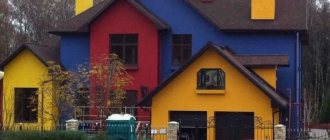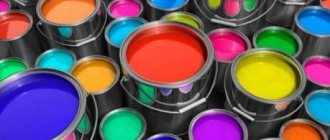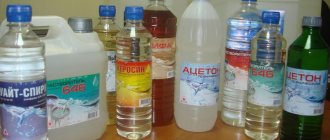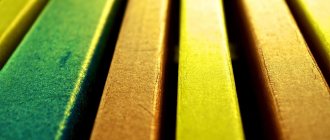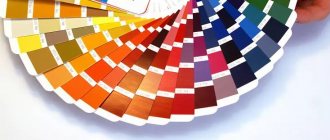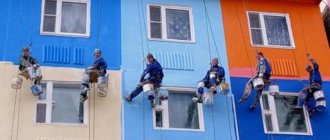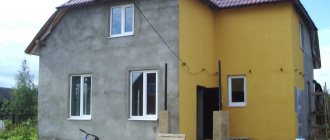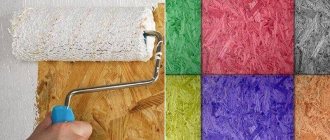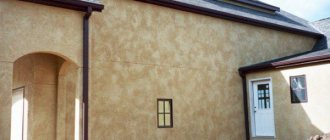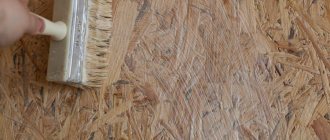Preparing the surface for painting
Before you start painting, you need to prepare the wall.
The first step is to clean the brick from dust, grease, efflorescence, and sometimes mold. If the wall has been painted before, you need to carefully remove the remnants of the old paint, otherwise the new layer applied will turn out uneven. To prepare the surface of a brick wall for painting, you will need the following tools:
- metal scraper;
- metal brush;
- Master OK;
- roller or brush.
Use a scraper to remove old paint; a wire brush will severely scratch the surface of the bricks. Dust is removed with simple warm water supplied under low pressure. But you cannot remove efflorescence or mold with water; you will only make the situation worse. The wall can be treated against mold with “Belizna” or other chlorine-containing preparations.
The most difficult thing is to get rid of the protruding salt. First you need to try to carefully remove the efflorescence using a stiff wire brush and wait a few days. If plaque appears again, you need to very carefully, observing all safety rules, treat the wall with ammonia or 5% acetic acid.
When working with a scraper or wire brush, you should try to preserve the cement joints as much as possible. If you still see cement spilling out in some place, you need to remove it. The same should be done in places where there are damaged bricks. Then, after slightly moistening the cleaned area, seal it with cement mortar. After leveling and removing any remaining cement, wait 3-4 days until the cement is completely dry.
Latex paint is considered the leader of all paints in terms of durability.
After finishing cleaning the wall and waiting for it to dry completely, you need to apply a primer. First, you need to apply a special primer varnish for brickwork to the surface with a roller or brush, which can penetrate into the brick and close open pores in it.
After waiting for the varnish to dry completely, treat the surface of the wall with a primer. The quality of painting directly depends on the quality of the primer, so it is better not to save money and purchase a special primer for bricks with increased water resistance.
First, prime the areas that have been cleared of grease, mold or efflorescence, and then the entire wall, applying a second layer of primer to the primed areas. 2-3 hours after applying the primer, you need to go over the entire wall with medium-hard sandpaper for better adhesion to the applied paint and proceed directly to painting.
Painting a brick wall can be done in two cases: when there is a need to change the appearance and after time has passed to restore its former beauty. If you choose the right color, you can emphasize the architectural features of the building - this is true when it comes to the facade. However, quite often a brick wall becomes part of the interior; in this case, it is also necessary to carefully choose paint and follow the technology for carrying out the work.
Dyeing process
Regardless of the color and drying speed of the dye, it is necessary to cover all elements that cannot be painted, otherwise they can also be painted.
The surface temperature must be at least 25 o. The actual painting of the brick wall begins from the upper right corner, gradually moving horizontally downwards.
It is important to ensure that there are no unpainted areas or, conversely, surfaces with an excessively high level of paint.
It is necessary to paint in several layers, before each one waiting until the previous one has completely dried. For the first layer, it is advisable to dilute the paint. Before applying the next layer of paint, the surface must be examined for drips and cracks. They need to be cleaned and sealed.
The main thing is not to choose façade paint by mistake. Of course, such materials are better suited for painting porous surfaces, but they contain many volatile substances that are hazardous to health. You will need interior paints - you can choose acrylic or alkyd for a matte or semi-gloss effect. Or use oil paint - it will give the brickwork a soft shine.
The primer should be selected taking into account the choice of paint, but in any case it should penetrate deeply into the base and create a durable water-repellent film. Apply a thick layer of primer - and be sure to let it dry completely.
Application instructions
To carry out painting work on building facades, painting tools such as a roller and brush are usually used. A more professional approach is the use of spray guns (spray guns). However, there are some nuances here, which is why it is better to turn to specialists for this painting method:
Before painting, the wall must be treated with water-repellent impregnation.
- When painting walls with a spray gun, the texture of the surface does not matter, but you need to have a set of nozzles that allow you to select the ideal size and intensity of the “torch” of the jet, as well as the quality of spraying. If there is only one nozzle, then it may not suit the consistency of the paint and it will have to be greatly diluted, which is extremely undesirable, such a layer will not last long.
- Sufficient compressor power is required. The pressure should be such that the coloring composition is sprayed, and large drops do not fly from the spray gun; this will affect the appearance of the facade being painted.
- Spray painting is not performed when applying a composition with a granular additive (textured paint).
It is best to use a roller when painting a brick wall. The length of the pile can be selected depending on the type and consistency of the painting material; by carefully rolling the wall, the paint will safely get into all the cracks and uneven surfaces.
Spray gun device for painting a wall.
In this case, the best paint savings are achieved, which is comparable to the specific consumption per 1 m2 indicated on the packaging. To apply a grainy paint composition, you can use textured attachments on a roller.
There is a rule that is recommended to be followed whenever possible: one façade should be painted entirely in one go. This is a guaranteed way to avoid shade differences at the boundaries of the areas being painted.
It is necessary to apply the composition evenly, without returning to one place several times, otherwise after drying there will be a noticeable stain of a more saturated color. The same applies to the boundaries of areas, which are best made somewhat blurred and not rolled over these places many times, so it is most convenient to do this work together.
After the first layer has completely dried, it will be possible to visually evaluate the result depending on the lighting of this side of the house. If defects and imperfections are noticed, they can be eliminated by additional rolling of the entire surface or part of it.
The quality of the result and the aesthetic appearance of your home depend on how meticulously and responsibly you approach the matter.
Therefore, when choosing materials, it is better to consult a sales representative who will recommend the coloring composition individually, in relation to your conditions.
Preparing the base
Initially, you should assess the condition of the wall. If there are chips, leveling using plaster is required. Before starting work, the base is cleaned of dust with a stiff brush. Afterwards, the masonry is washed with a cleaning mixture with foam and left to dry for about a week.
If there is concrete on the brick, then you need to get rid of it, and how to do this, watch the following video:
If the surface does not have rough irregularities, minor defects are masked with putty. After it dries, a primer is needed to protect it from the negative effects of moisture. If the wall surface is located in an unheated space, then it is treated with anti-fungal impregnation. The antifungal solution is odorless and colorless, and dries within 24 hours.
Brick painting
Properties and purpose
For these purposes, the wall surface should be covered with a protective layer of paint or varnish, which should have the following properties:
- Water resistance
. This quality is especially important because the cladding of bathrooms, toilets and kitchens must also withstand high humidity. In addition, moisture-resistant paint is easy to clean, and your walls will always look like new; - Vapor permeability
. The beauty of brick walls lies in their ability to “breathe,” that is, to allow water vapor to pass from inside to outside. To ensure that such emission is not disturbed, the paint must be vapor-permeable; - Resistance to ultraviolet radiation and other types of solar radiation
. Under the influence of light in the UV spectrum, many materials fade over time, which is unacceptable for facade and interior paints; - If the surface is located outdoors, its coating must be frost-resistant
; - Elasticity
. The film covering the brick must be sufficiently elastic so as not to crack or peel when geometry changes during shrinkage processes and thermal expansion of the material; - Good coverage of porous and heterogeneous surfaces
. Not all paints are suitable for working with materials and surfaces such as brickwork, and the consumption may be too high.
Materials
The modern building materials market provides a huge selection of coatings, paints, varnishes and primers for treating various surfaces, including brick.
To avoid making mistakes when choosing the right material, follow these principles:
Look for materials made with water or compounds that are safe for humans. Previously, they were prepared on the basis of organic solvents, since only with such a composition it was possible to achieve the desired coating qualities
Today the situation has changed, and excellent and reliable paints and varnishes are made based on water; Be sure to pay attention to the purpose of the coating specified in the manufacturer's instructions. Pay special attention to the place of use: external or internal work, dry or wet rooms, heated or unheated, etc.; Choose materials with good vapor permeability
A brick wall absorbs moisture from the interior and releases it outside, so the paint must allow water vapor to pass through; Check whether the option you choose is suitable for processing porous and heterogeneous surfaces; Give preference to well-known manufacturers with a good reputation and a solid history of producing quality materials. It is best to buy products from European manufacturers, such as Tikkurila, Belinka, Caparol, Dulux and other companies of this level.
Any cement, silicate or polymer paint is suitable for painting a brick surface; you can also use varnishes and glazes, but experts advise choosing acrylic water-dispersion paint. This material is absolutely harmless, strong, beautiful and durable.
For interior work, you can use water-based varnish. Modern scuba tanks look great and have excellent characteristics, they are completely harmless and have a long service life.
After choosing a paint, immediately select a primer. For acrylic dispersion, medium or deep penetration acrylic primer should be used. It would also be a good idea to immediately purchase an antifungal compound and a product for removing efflorescence from the wall.
Required material and tools
To obtain high-quality painting, you will need to purchase everything necessary for this. Materials you will need:
- Dye.
- Cement.
- Putty.
- Primer.
- Vinegar and water.
To make it easier to apply materials, you need to acquire the following tools:
- With a roller.
- 2 flat brushes (approx. 100 mm and 50 mm wide).
- With a brush.
- Sandpaper.
- Spray bottle.
- Safety glasses.
- Rubber gloves.
When choosing tools, it is advisable to pay attention to the material from which they are made. It is best to give preference to coarse bristles on the brush and metal wire on the brush. This will significantly reduce tool consumption.
Brick surface painting
While the plaster is drying, you can prepare the required amount of paint for painting the plaster to look like brick. The dosage of red-brown, red, orange and black can be easily selected when painting a small sample, and then transferred in the required proportions to the entire volume of paint for the entire wall area. Before starting painting, it is necessary to prime the relief surface of the wall with imitation brickwork using a primer. You can use a roller or a wide brush.
After drying the surface, you need to start painting the bricks with the prepared paint with the addition of the required color.
You can achieve a color scheme that absolutely matches the color of the ceramic brick. In this case, it is better to paint with a brush, although you can also use a roller. After painting the entire surface, all you have to do is wait until it dries and paint the seams.
View of a finished wall made of plaster
For this purpose, it is a good idea to use Vetonit LR finishing putty. It is brought to the required consistency and a little black Tex is added. This thick putty is applied with a narrow brush, 3.5 cm wide, to all the seams between the bricks. The effect will be very original, no different from natural brickwork.
All you have to do is wait for it to dry and apply a protective varnish. You can keep it simple and paint all the seams with white Tex paint. Those who are not satisfied with the red color of the brick can simply paint the entire surface with white acrylic paint.
Protective varnish coating
After the surface with imitation brickwork has completely dried, it is necessary to apply a protective coating with varnish. This will allow you to carry out wet cleaning in the future without fear of damaging the painted surface. For this purpose, it is better to choose matte acrylic varnish for parquet work.
After varnishing and drying, you can consider the work done.
Additional information: How to paint imitation brick from plaster
A brick wall is relevant among various interior styles, but when it is impossible to build it, it can be imitated in some way. How to paint a brick wall made of plaster? In this article we will look at how you can paint a brick wall without resorting to the services of artists.
Three methods will be presented, which will require simple materials, a little patience and accuracy.
At all times, people have strived to make their home beautiful. A variety of finishing materials, unusual furniture, original ceiling designs and much more can add style and originality to any room. But quite often a situation arises when you want to get the most effective result with a minimum of funds.
This option includes finishing the walls with brick-like plaster.
Design solutions in the interior can be so different that studio clients sometimes do not have enough words to describe the options that are offered to them for organizing the space inside their home. A resident of a usually metropolitan apartment, through certain manipulations with the internal space, can feel like he is in a remote taiga, where the walls turn out to be similar to a hut built from thick, unhewn logs. Another direction of architectural delights could be the loft style, in which a person feels like he is in a factory.
The feeling is as if the work shift had just ended and everyone had left the enterprise.
The mixture is scooped up with a spatula and thrown onto the surface, then leveled upward. If you want a brick wall made with your own hands from plaster to look as unnatural as possible, do not try to smooth the surface too much. Brick is rarely perfectly smooth; more often it is rough and has irregularities.
It will be impossible to restore the original appearance of the painted wall of the house; it is impossible to remove the applied coating from the brick; in the future, only repainting is possible. Moreover, the layer will last no more than five years. And as a natural material, brick will ooze efflorescence and moisture, which over time will spoil the appearance of the finish.
In any case, the operation must be approached with due responsibility, since incorrectly done work with your own hands will give the walls the appearance of a cheap craft.
- the ability to work with solutions that harden quickly, since they have time to “set” and dry;
- a large selection of materials and flexibility in carrying out any set of works. The shape of the structure fully repeats the elements already discussed;
- the ability to create a template directly on the wall and an image of any shape;
- naturalness and authenticity of the appearance of the resulting brickwork.
To work with plaster, two steel spatulas (20 cm, 5 cm) are used. Using a narrow tool, the mixture is applied to a wide one. Also, small defects (protrusions, pits) are corrected with a small spatula.
Using a wide spatula, the base is spread with gypsum plaster (starting from the edge), the layer is leveled. The work is carried out in separate sections, their area depends on the volume of the prepared solution (up to 15 liters are mixed at one time). There is no point in achieving a perfectly flat surface (natural brick is not like that).
To apply seams, you can use a stencil for brick plaster.
Types of coatings
Facade paint for bricks is based on water or organic compounds. Each variety has its own characteristics, positive and negative sides.
It is important for the buyer to decide which properties to give priority to
Organosoluble nitro enamels and oil dyes
They have the following characteristics:
- Good penetration into brick structure.
- UV resistant.
- Creation of a thin water-repellent film on the surface, which prevents the original material from “breathing”. Because of this, condensation appears on the surface in large quantities.
Organosoluble paints for facades are recommended to be avoided by those who are furnishing the interior of residential premises. Otherwise, the walls will become damp too quickly, and the microclimate inside will be disrupted. External facades, fences and brick walls are optimal for paints. The composition of the material is toxic. At the same time, it is protected from burnout and atmospheric precipitation.
Water soluble
These are some of the most durable paints for painting walls. They are even suitable for processing gas heating drafts and stove heating pipes. Sometimes this material is used for finishing work inside the house. Compatible with different types of materials:
- Gypsum tiles with brick imitation.
- Gypsum, silicate brick.
- Simple brick.
Water-soluble paints are capable of transmitting steam. Exchange of gases and liquids occurs normally between the atmosphere and the surface. Fireproof, non-toxic material. It is allowed to use it to decorate the interior of premises. Some varieties have heat-resistant qualities when painted.
Epoxy
Customers can give the compositions different properties according to their wishes. Resins have a toxic or non-toxic composition. Adhesion properties and high strength are always characteristic of paints. Atmospheric precipitation can cause some damage to materials. Painting the inside of walls with this composition will guarantee durability and high-quality coating. Can be used inside covered balconies.
Mineral
The basis for the manufacture of the material in this case is ordinary cement. This paint is suitable for painting facades from both a practical and decorative point of view. The paint can be used to treat balconies and fences. It has the following characteristics when painting sand-lime brick with facade paints:
- Water resistance.
- Heat resistance.
- High temperatures and large amounts of precipitation do not cause serious damage.
The fence or façade of buildings will be reliably protected from further damage. This option is rarely seen when interior spaces are being decorated.
Silicone
Mixtures with silicone are the choice for buyers if the base has low adhesion properties. Such materials are well distributed over the treated surfaces. For a long time they are able not to change color. Stoves and fireplaces are decorated with heat-resistant varieties.
Technology and choice of paint for interior work
As we have already mentioned, interior paints cannot contain harmful chemical compounds. Paint is applied in most cases with a roller or brush. There are options for painting the surface of bricks and seams in various colors.
Before starting work, take measures to protect floor coverings from paint. Cover them with thick paper or plastic wrap. Clear your workspace and place the paint container in a convenient place. Be careful not to spill paint on the floor.
Practical advice. The roller should move at a moderate speed. Rotating too quickly can cause paint splatters to fly over long distances and land on other objects.
The second layer is applied after the first has partially dried; to improve adhesion, do not let it dry completely. How to check the position of the first layer? Gently run your fingertips over the surface; if they stick a little, you can apply a second coat of paint.
Things to consider before painting
If you are thinking about how to beautifully paint a brick wall, consider a few nuances:
- It is not advisable to paint fresh masonry. Before you continue work, the processes of weathering, drying, and leaching must be completed. To avoid the occurrence of defects on the painted surface, you need to wait a year from the time of construction of the masonry, and only then proceed with further finishing.
- Brick in most cases is not intended for use in such finishing, so it will be very difficult to remove paint from it later. This is due to the structure of the material: the porous, rather uneven surface will not allow radical changes again without hassle.
- Such painting will require periodic updating (every 5 years).
Fortunately, the disadvantages are easily compensated by the advantages that painting entails:
you will divert attention from wall defects that have been affected by time; you can change the color of the masonry so that it fits better with various interior details, when it comes to interior walls, and other buildings when you are working on the facade of a building; create a fashionable, modern style.
We take into account the nature of the material
Brick, as a natural material, has a special porous structure, which, in general, is difficult to paint. The paint simply soaks into the brick surface, and in order to get uniform, smooth bricks, you will have to apply several layers, waiting until each new layer dries completely.
In addition, no matter how durable the layer of paint on a brick surface is, most likely, after a few years it will begin to crumble, revealing specific salt deposits.
How to choose paint?
The building materials market today offers a huge range of paints. They differ in composition, base, scope of application and price. Choosing the right quality paint is the key to a long service life of the coating. You need to approach its purchase very thoroughly.
First of all, you need to answer the question, what kind of wall are you going to paint? Will it be interior or exterior?
Option for outdoor use
When choosing paint to paint the wall of your own country house or any other building, pay attention to a number of parameters
Vapor permeability. This indicator is of key importance if the entire wall mass is made of brick. By completely painting the façade with paint, you will deprive the walls of the opportunity to “breathe.” Competent builders provide special ventilation gaps for these purposes. In this case, you can choose a paint that does not have high or even medium vapor conductivity. The same rule applies to buildings whose facade is only decorated with brick; only cladding is done with it.
Have you noticed that very often the paint on the seams is the first to break down. This happens due to illiterate selection of material. The fact is that the concrete mixture contains alkali
Not all paints are resistant to it, so when choosing, you should pay attention to this aspect.
Waterproof. Different types of brick have their own moisture absorption rate, so the material must be protected
Paint copes with this successfully. It should not let or absorb water.
It must be taken with high adhesion. The paint must adhere well to the surface it is applied to. Moreover, brick is a porous building material. This definitely needs to be taken into account. To reduce paint consumption, it must have a high hiding power (so that it covers the previous layer).
Types of paints for exterior finishing
There are several types that are well suited for painting exterior brick. Each of them has its own advantages and disadvantages.
- Acrylic. One of the most popular materials for painting walls. Although vapor permeability is not high, it is quite enough. The main advantage is its ability to prevent the appearance of salt stains. This is one of the main problems of decorative finishing materials.
- Silicone. One of the main rules for painting brick walls is to wait a year after laying it out. A brick wall is painted only a year after construction. This type of paint allows you to do this after just a week. Elasticity gives it this advantage. Even if the masonry shrinks, the coating will remain unchanged. The obvious disadvantage is the high cost.
- Silicate. This enamel will pleasantly surprise you with its price, but its characteristics leave much to be desired. Most likely, the wall will have to be updated in 2 or 3 years. The fact is that the paint and varnish material is not very resistant to aggressive environmental influences.
Interior work
In modern stylish interiors you can often find brickwork. It is quite acceptable for styles such as loft, rustic or industrial. Choosing paint is an important step. The final result and aesthetics of the interior will depend on it.
The main criteria that should underlie the choice are as follows:
- environmental friendliness;
- decorative effect.
All these requirements are met by a type such as water-dispersion paint, otherwise it is also called water-based paint. The base can be acrylic, then the paint will last a very long time. There may be minerals.
Painting brick walls outside
When carrying out work, preparation is given the most attention. This stage determines how reliable and durable the coating will be later. Painting facing bricks takes a little time.
The following actions simplify the preparation of facades:
- Special devices are used when cleaning from fungus and mold.
- Use ordinary water to get rid of salt stains and stains. A stiff brush will also become an indispensable assistant when performing such work. It is not recommended to solve the problem with acidic compounds.
- To get rid of traces of dirt and dust, soap solutions help here.
- Puttying, thorough plastering of the surface.
- Renewing joints in masonry.
- Priming process.
Dryness and cleanliness are mandatory requirements for walls by the time they are painted.
Caring for Painted Brick
A painted brick wall has a service life of approximately 5 years. Therefore, such a surface requires proper care. If minor dirt appears, the wall can be easily washed with a regular soap solution. A soft sponge is used for this. After washing, wipe the surface with a soft, dry cloth.
If abrasions occur in some places during use, they can be painted over with paint of a suitable tone. If the brick was previously painted with fade-resistant paint, then the new painted areas will not show up much.
Types of paint and varnish coatings
Let's look at the main types of wear-resistant brick paints intended for outdoor use.
Acrylic
Such compositions are characterized by good resistance to temperature changes and can be used for eight to eleven years. Walls painted with acrylic paint do not develop cracks and respond normally to wet cleaning. The covering layer does not crumble from exposure to sunlight and precipitation. The main component of the composition is a resin that does not absorb water well.
It is believed that newly erected brick walls should not be painted immediately, but this restriction does not apply to alkyd compositions. They contain a binder component that counteracts the alkali corrosion characteristic of fresh masonry mortar. So if a month has passed since the construction work, you can safely paint the walls with acrylic composition.
Silicone
Paints in this group have good durability and dry within three hours after application. The siloxane composition present in the material reliably protects the surface from the formation of fungal mold. When exposed to ultraviolet light, the paint does not change its original shade.
Silicate
Dust and dirt are removed naturally from a brick surface painted with this composition when precipitation occurs. A house painted with silicate paint will last for twenty years without requiring repairs. The main color of silicate group paints is considered to be white, but by adding dyes it can be converted to another shade.
The material is applied in two layers, with an interval of one day.
Enamel
The material is toxic and flammable and contains varnish. It has good water resistance, strength and corrosion resistance. Final drying occurs after six to twenty hours.
Water soluble
Durable paint used for painting wall facades. This material can be used to paint brick chimneys and perform interior decoration. Water-soluble paint is an excellent choice for facing, gypsum or sand-lime bricks. It is characterized by sufficient vapor permeability, guarantees complete exchange of moisture and gas between the wall and the atmosphere, does not contain toxic additives, and is not flammable.
Mineral
Such paints are made on the basis of cement material, are excellent for finishing facades, have good resistance to moisture and temperature changes, and create a reliable protective layer for brick walls. The operational period is ten years or more.

